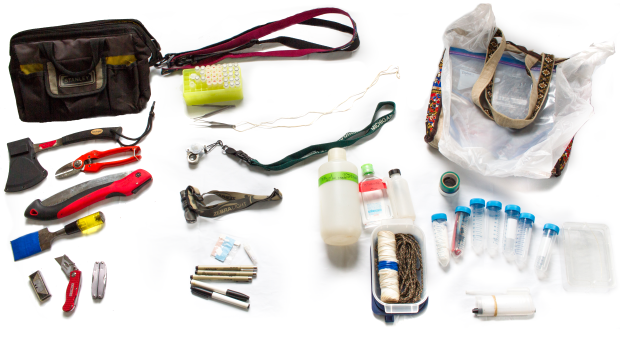This page is currently a work in progress intended to help aid in packing for international and domestic collecting trips
Collecting tools
The selection of tools partly depends on which types of scolytine beetles you are mostly interested in. For example, for twig bark beetles you will not need any of the heavy duty hardware. On the other hand, trying to pry ambrosia beetles out of a branch with a knife routinely leads to squashed specimens (for xylophages we recommend sawing out a wood “cookie” with the gallery in it, splitting it out with a chisel, and peeling pieces off with clippers, until you get at the beetle). Our recommendations of brands are based on years of experience, not on any relationship with the vendors.
If you have everything shown in the photo- you should be set for both wood and trap collecting.
Essential – extracting beetles alive or into ethanol
- Tool/gear bag with strap
- Hatchet
- Anvil-style clippers (we recommend Bahco)
- Folding saw
- Chisel
- Knife/box cutter (heavy duty), extra blades
- Collection tubes prepped with ethanol, in collection box
- Soft forceps (for grabbing beetles), with spare and loop for neck
- Hard forceps (for careful bark dissections)
- Headlamp (useful even in daytime)
- Pre-cut collection labels
- Labeling pens (we recommend .5 Pigma MICRON archival pen)
- Collection bags, various sizes (for carrying sticks to dissect later)
- Any tubes or other container with holes poked (for live specimens)
- Kimwipes/tissues (for live specimens)
Funnel/bottle trapping
- Lindgren traps or bottle traps (2L bottles or materials to make them (see below, also: http://ambrosiasymbiosis.org/wp-content/uploads/2013/03/bbtrap.pdf)
- Knife for constructing bottle traps, cutting rope
- Rope and/or twine
- Twist-ties or cable ties
- Tape (electrical)
- Lures, or >95% un-denatured etoh (seal in drinking alcohol bottle for checked luggage to pass TSA)
- Bags for lures/ethanol
- Squirt-bottle for re-filling etoh bags and tubes
- Plastic pasteur pipette
- Collection bags, various sizes (for carrying sticks to dissect later)
- Any tubes or other container with holes poked (for live specimens)
- Kimwipes/tissues (for live specimens)
- Labeling equipment (Pigma pens, labels)
Light-trapping
- Light source of choice, batteries, etc.
- We typically use at least two white (UltraFire Sk98 Cree Xml-t6) and two black (UltraFire SK98 UV) flashlights per sheet
- Voltage converter if necessary
- glasses with UV protection
- White sheet (Queen size is best, usually can borrow from a hotel)
- Rope/twine to hang sheet
- Clips/clothespins
- Bowl/tray for ethanol
Not essential but useful
- Ethanol-resistant labeling markers
- Tarp for cutting-up wood indoors (easy clean-up)
- Multi-tool
- Collecting notebook/log
- Aspirator (pooter)
- Electric or regular chain saw (remove oil if packing, also pack oil and allen wrench)
- Scalpel (for very small galleries)
- Pin/teasing needle (small galleries, can also just use hard forceps)
- Watch glasses for IDing in the lab, under a scope.
Generally useful in travel
- Power adapter
- …
If culturing fungi from wood/beetles:
Dry media
Plates
Scalpel and blades
Spreaders
Rubber gloves (1 box, transferred to zip-loc bag)
Minuten pins
100 uL Pipette
100 uL pipette tips – autoclaved (figure 20 tips/beetle, e.g. 30 beetle isolations = 600 tips)
Parafilm
Lighter
Pellet pestles (~20)
1.5 mL tubes
1.5 mL tubes prepped with PBS for serial dilutions (15/beetle, 30 beetle isolations =450 tubes)
Tube of Tween
Tube rack
Cryotube slants (pre-made, in cardboard vial boxes, generally 125+)
Extra empty sterile cryotubes
Extra empty sterile 1.5 mL tubes
Mite paper – 3’ folded and stored in zip-loc bag to extend effective life
Gallon zip-loc bags to put plates in (mite protection)
Permits and labels for shipping fungi back
Padded envelopes/small boxes for shipping slants back
Packing tape
Arrange for in advance
Permits for shipping fungi arranged
Travel authorization submitted to Cindy Love
Completed online travel registration checklist found here: http://ufic.ufl.edu/travelregistration.html
Team Assist insurance set up, card printed to take on trip
Vaccinations if required/recommended for destination
International calling setup on cell phone
International driver’s license (if renting car)
Pcard/personal credit/debit card travel authorizations
Accommodation reservations
Things to make sure are available at destination/hosting lab in advance (if needed)
Plates plus potentially other lab tools, consumables listed above (allow time for hosting lab to order to ensure arrival in time)
Autoclave
Glassware for autoclaving media
Sterile hood
Bulk ethanol (lots necessary if trapping – illegal to fly with large amounts of ethanol)
Microscopes
Microscope camera
Printing capabilities
WiFi and printing capability
Incubators
traps to borrow

